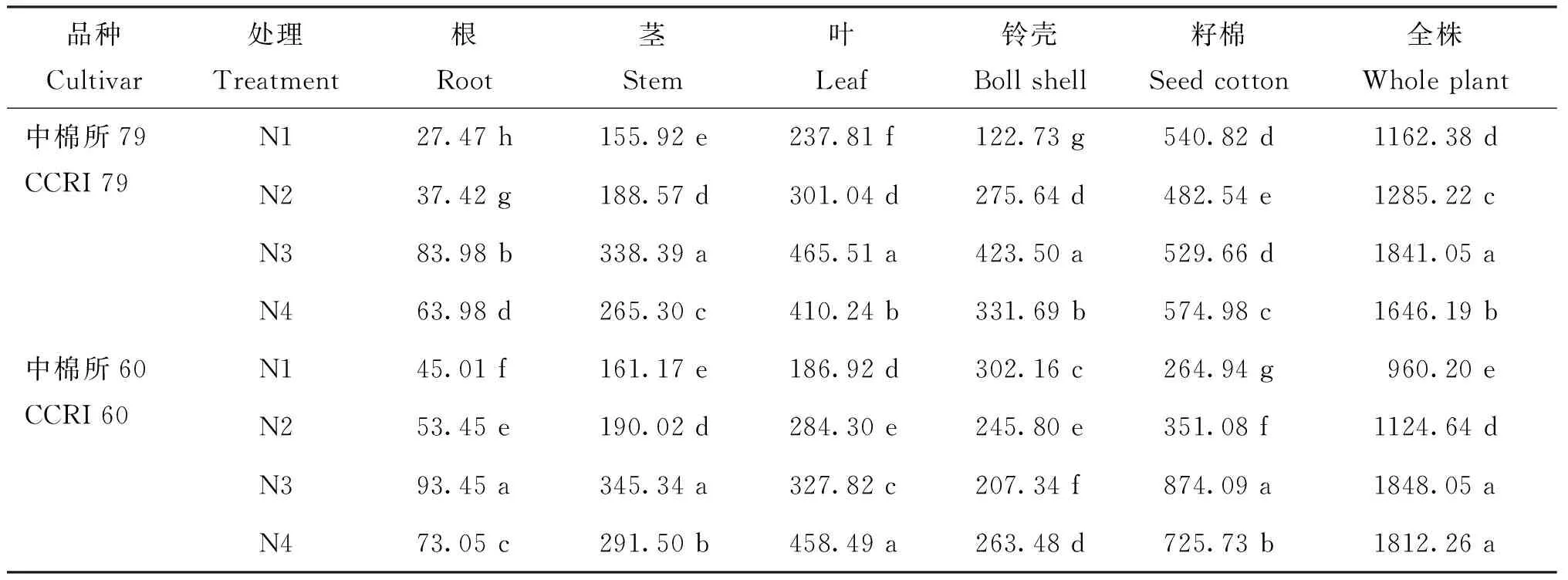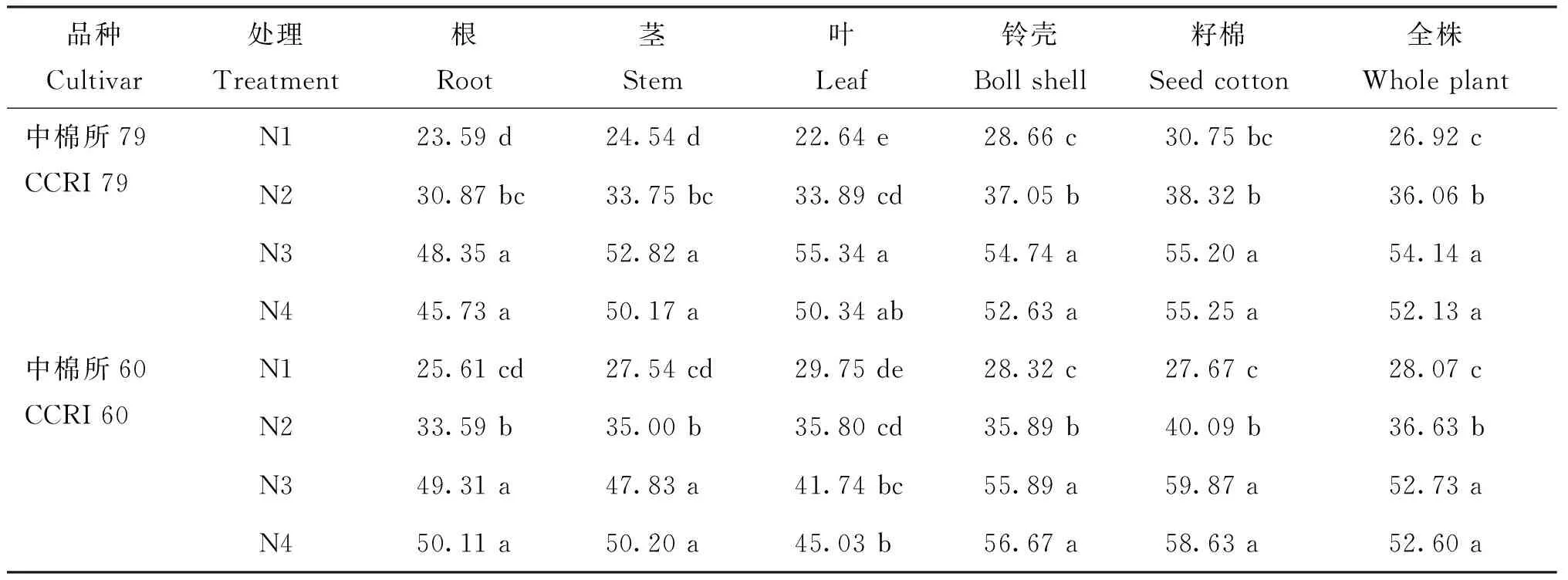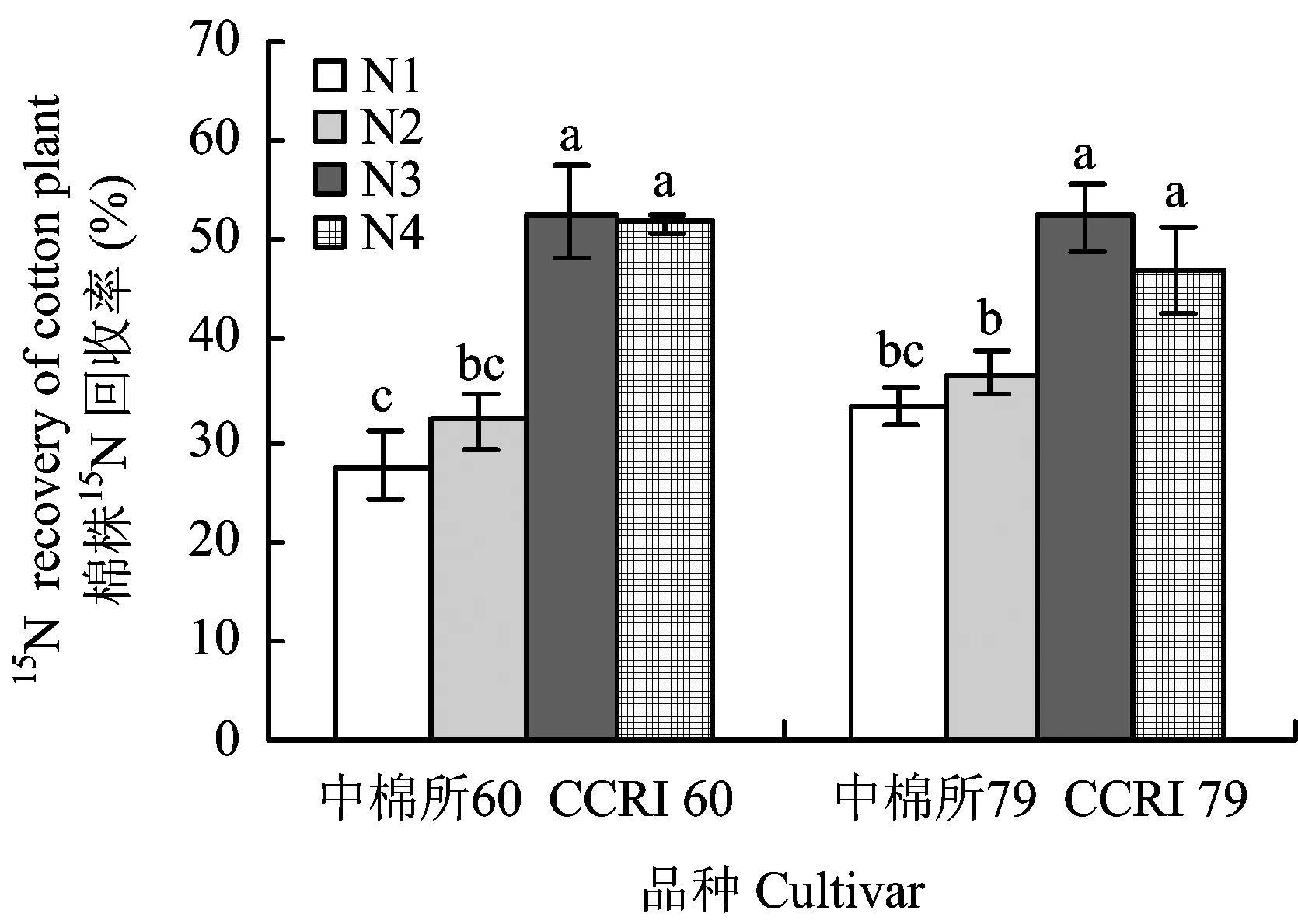应用15N研究氮肥运筹对棉花氮素吸收利用及产量的影响
2015-06-15李鹏程董合林刘爱忠刘敬然李如义李亚兵毛树春
李鹏程, 董合林, 刘爱忠, 刘敬然, 李如义, 孙 淼, 李亚兵, 毛树春
(中国农业科学院棉花研究所,棉花生物学国家重点实验室,河南安阳 455000)
应用15N研究氮肥运筹对棉花氮素吸收利用及产量的影响
李鹏程, 董合林*, 刘爱忠, 刘敬然, 李如义, 孙 淼, 李亚兵, 毛树春*
(中国农业科学院棉花研究所,棉花生物学国家重点实验室,河南安阳 455000)

15N示踪技术; 氮肥运筹; 棉花; 氮吸收利用; 产量
氮是作物生长必需的大量元素之一,作物吸收的氮一部分来源于土壤,一部分来源于施入的氮肥。氮同位素示踪技术能区分作物吸收利用的肥料氮及土壤氮,运用此技术测定的作物氮素利用率能真实地反映作物实际利用肥料的状态[1],并能深入细致研究施入氮肥的去向及在作物体内的分配[2-7],为作物氮肥运筹管理提供理论依据。
有关棉花适宜的施氮时期存在争议,国外有学者推荐最佳施氮时期为出苗后和现蕾期[8],也有研究认为播前和初花期各施一半较好[9]。国内有研究认为棉株中的氮素主要来自土壤,占棉株总氮量的53%以上;棉株生育前期对土壤氮的依赖性较高,而后期对肥料氮的依赖性较高[10],这一结果为棉花底氮后移提供了理论依据。滴灌条件下增加施氮次数[11]、滴灌时先滴一半肥液再滴一半清水[12-13]有利于提高棉花的氮肥利用率。棉花氮肥施氮时期、施氮次数、底施与追施比例对氮素吸收、产量及氮肥利用率的影响值得深入研究。黄河流域棉区氮肥施用习惯为底肥与初花期追肥各施一半,这种施氮方式是不是兼顾产量与氮肥利用率的最佳方式尚不明确。 本文拟采用盆栽试验,使用氮同位素示踪技术,设计氮肥底施与初花期追施比例为1 ∶2和0 ∶1,底施氮与蕾期追氮比例为0 ∶1,以底氮与初花期追氮比例1 ∶1为对照,研究底氮后移以及一次性施氮对棉花生物量及氮素积累、籽棉产量及氮肥利用率的影响,以期为黄河流域棉区氮肥合理运筹提供理论依据。
1 材料与方法
盆栽试验于2013年在河南省安阳市中国农业科学院棉花研究所试验农场进行。以转Bt+CpTI基因中熟常规品种中棉所79(CCRI79)和中棉所60(CCRI79)为材料,设氮肥底施与初花期追施比例1 ∶1(N1)、1 ∶2 (N2)、0 ∶1(N3)、氮肥底施与蕾期追施比例0 ∶1(N4)4个处理(表1),每处理重复10次,随机区组设计。试验用盆为塑料花盆,上部内直径35 cm,底部内直径30 cm,高39 cm。每盆装土35 kg,供试土壤有机质含量10.5 g/kg,全氮0.73 g/kg,碱解氮68.2 mg/kg,速效磷10.6 mg/kg,速效钾99.4 mg/kg。
所有处理磷、钾肥用量相同,并全部作底肥。磷肥用过磷酸钙(P2O5含量42%),每盆施8.33 g,钾肥用硫酸钾(含K2O 51%),每盆用量6.86 g。氮肥为硫酸铵 (含N 21%,上海化工研究院生产),15N丰度10.08,每盆纯氮总用量均为3.5 g。 于2013年4月8日装土并施入底肥,花盆按行距0.8 m、株距0.7 m摆放,并埋入土壤中。4月25日播种,5月2日出苗,6月10日现蕾,7月8日开花,9月5日吐絮。6月12日追施蕾期氮肥,7月10日追初花期氮肥。

表1 盆栽试验棉花施氮量及施氮时期
1.2 采样及测定
于初花期(7月10日)、收获期(9月20日)每处理取4株,初花期分根(子叶节以下)、茎、叶、花蕾,成熟期分根、茎、叶、铃壳、籽棉,于电热恒温干燥箱内105℃杀青30 min后80℃烘干至恒重,用万分之一天平称量生物量,粉碎待用。成熟期取0—30 cm土壤混合样,每处理取4个重复,自然风干后磨碎,过0.25 mm筛备用。植物不同部位和土壤全氮含量用半微量凯氏定氮法测定,15N丰度用ZHT-03(北京化工仪器厂)质谱计测定。
棉株不同部位氮吸收量、棉株吸收的氮素来自氮肥(Ndff %)、氮肥回收率的计算参照王富林等[14]的方法,公式如下:
棉株不同部位氮吸收量(g) =棉株不同部位生物量(g)×全氮含量;
作为一种非常重要的中枢神经系统兴奋性神经递质受体,NMDA受体是一种谷氨酸离子型的受体,可以对突触传导、突触可塑性与神经细胞变形调节,并增强长时程。包含3个亚基编码基因对于NMDA受体来说,分别为NR1、NR2、NR3。其中,功能性NMDA受体必不可少的就是NRI8种不同剪切受体;NR2具备的基因编码亚型有4种,且都是不同的;NR3由两个亚型组成,分别为NR3A、3B。当神经纤维发生病理变化时,比如缺血缺氧与神经损伤,会出现相反作用对于过度活化的NMDA来说。总体来说,需要遵循一个钟型曲线对于NMDA受体神经元对兴奋性谷氨酸递质反应来说,无论是轻微还是高强度的激活受体,都是不健康的。
Ndff(%) =(棉株不同器官中15N丰度-0.3663)/(肥料中15N丰度-0.3663)×100;
棉株不同器官15N累积量(mg)=棉株不同器官全氮吸收量(g)×Ndff %×1000;
棉株15N回收率(%)=棉株体内15N含量/15N施入量×100;
土壤15N回收率(%)=土壤中15N含量/15N施入量×100。
1.3 数据处理
所有数据采用Excel 2007和DPS 11.0软件进行统计与分析。
2 结果与分析
2.1 氮肥运筹对棉花不同器官生物量及籽棉产量的影响
由表2可以看出,初花期2个棉花品种不同施氮处理间棉株的根、花蕾部分生物量差异不显著,2个品种N4处理根、花蕾部分生物量在4个施氮处理中最高,说明蕾期施氮对棉花地下部的生长及花蕾的发育有促进作用。中棉所79的 N1处理单株生物量在4个处理中最高,而中棉所60 的N3处理的单株生物量在4个处理中最高,但各处理间的单株生物量差异不显著,说明了底施氮肥对初花期的棉花单株生物量影响较小。
收获期相同品种不同施氮处理间棉株根、茎、叶、铃壳的生物量差异不显著,单株籽棉产量均以N2处理最高(表3)。中棉所79各处理间单株籽棉产量、单株生物量无显著差异,N2处理单株籽棉产量比N1高5.5%。中棉所60 的N2处理的单株籽棉产量、生物量显著高于N4处理,但与N1、N3处理间的差异不显著,N2处理单株籽棉产量比N1高4.4%。结果表明,底氮与初花期追氮比例为1 ∶2时可促进棉花生物量的积累,相比常规施氮(底追比为1 ∶1)有一定增产作用。

表2 初花期棉株不同器官生物量(g/plant)
注(Note): 同列数据后不同字母表示处理间差异达5%显著水平 Values followed by different letters in a column are significant among treatments at the 5% level.

表3 收获期棉株不同器官生物量(g/plant)
注(Note): 同列数据后不同字母表示处理间差异达5%显著水平 Values followed by different letters in a column are significant among treatments at the 5% level.
2.2 氮肥运筹对15N丰度及15N积累量的影响
表4显示,初花期2个品种N1处理的主茎15N丰度大于花蕾、叶,根15N丰度最低。2个品种N4处理花蕾15N丰度大于根、茎,叶15N丰度最低,N2处理棉花初花期根、茎、叶、花蕾之间的15N丰度较接近。2个品种N1处理的根、茎、叶、花蕾的15N丰度均显著高于N2和N4,N4花蕾的15N丰度显著高于N2。
初花期各处理棉花的叶15N积累量最高,其次是主茎、花蕾,根部最少(表5)。N4处理花蕾的15N积累量高于N2,与15N丰度结果一致,说明蕾期施氮促进了花蕾的发育及其对氮肥的吸收利用。中棉所79的 N1处理的全株15N积累量显著高于N2、N4处理,中棉所60 的N1、N2处理的全株15N积累量显著高于N4。
表6结果表明,收获期棉花除了中棉所79的N3处理、中棉所60 的N1处理外,其他处理的籽棉15N丰度均比其他部位高。中棉所79 的N3处理的根、茎、叶、铃壳的15N丰度高于N1、N2、N4处理,N4处理的籽棉15N丰度显著高于N1、N2,与N3处理差异不显著。中棉所60 的N4处理的根、茎、叶、铃壳的15N丰度高于N1、N2、N3处理,N3处理籽棉的15N丰度在4个处理中最高,与中棉所79的结果一致。说明初花期施氮可促进生殖器官对肥料氮的吸收。 除了中棉所60的 N1处理外,其他处理的籽棉15N积累量均高于根、茎、叶、铃壳(表7)。中棉所79 的N4处理籽棉15N积累量最高,其次是N3、N1,N2最低。中棉所60 的N3处理籽棉15N积累量最高,其次是N4、N2,N1最低。2个品种N3、N4处理的全株15N积累量均显著高于N2和N1处理,说明蕾期或初花期一次性施氮有利于棉花的生殖生长,增加了生殖器官对肥料氮的吸收量。

表4 初花期棉花不同器官15N丰度(%)
注(Note): 同列数据后不同字母表示处理间差异达5%显著水平 Values followed by different letters in a column are significant among treatments at the 5% level.

表5 初花期棉花不同器官15N积累量(mg/plant)
注(Note): 同列数据后不同字母表示处理间差异达5%显著水平 Values followed by different letters in a column are significant among treatments at the 5% level.

表6 收获期棉花不同器官15N丰度(%)
注(Note): 同列数据后不同字母表示处理间差异达5%显著水平 Values followed by different letters in a column are significant among treatments at the 5% level.

表7 收获期棉花不同器官15N积累量(mg/plant)
注(Note): 同列数据后不同字母表示处理间差异达5%显著水平 Values followed by different letters in a column are significant among treatments at the 5% level.
2.3 氮肥运筹对棉株吸收的氮素来自氮肥的比例(Ndff%)及15N回收率的影响


表8 初花期棉花不同器官吸收的氮素来自氮肥的比例(%)
注(Note): 同列数据后不同字母表示处理间差异达5%显著水平 Values followed by different letters in a column are significant among treatments at the 5% level.

表9 收获期棉花不同器官吸收的氮素来自氮肥的比例(%)
注(Note): 同列数据后不同字母表示处理间差异达5%显著水平 Values followed by different letters in a column are significant among treatments at the 5% level.


图1 氮肥运筹对初花期棉花植株15N回收率的影响Fig.1 Effects of nitrogen application strategy on 15N recovery of cotton plants at the initial flowering stage[注(Note): 柱上不同字母表示处理间差异达5%显著水平 Different letters above the bars mean significant among treatments at the 5% level.]

图2 氮肥运筹对棉花植株收获期15N回收率的影响Fig.2 Effects of nitrogen application strategy on 15N recovery of cotton plants at the harvest stage[注(Note): 柱上不同字母表示处理间差异达5%显著水平 Different letters above the bars mean significant among treatment at the 5% level.]

图3 氮肥运筹对棉花收获后土壤15N回收率的影响Fig.3 15N recovery of soil in the pot experiment of cotton after the harvest with different N application treatments[注(Note): 柱上不同字母表示处理间差异达5%显著水平 Different letters above the bars mean significant among treatments at the 5% levels]

2.4 氮肥运筹对棉花收获后土壤15N回收率的影响

3 讨论与结论
有关氮肥基追比例对作物产量的影响在小麦、玉米、棉花等作物中均有报道。王晓英等[15]报道,强筋小麦济麦20号基肥、 拔节肥比例3 ∶17处理优于基肥、 拔节肥比例1 ∶1处理,能提高小麦产量与品质;战秀梅等[16]报道,春玉米氮肥减量后移能获得较高的产量,同时也能提高氮效率;赵士诚等[17]报道,夏玉米氮肥减量后移能节省氮肥,产量并不下降。以上研究表明,减少基施氮肥比例增加追施氮肥的比例能提高小麦、玉米等作物的氮肥利用率,达到增产或稳产的效果。氮肥基追比例对棉花产量的影响研究结果不尽一致,马宗斌等[18-19]报道,黄河滩区棉花施用基肥、花铃肥和盖顶肥的比例为0.4 ∶0.4 ∶0.2时,籽棉产量高于基肥、花铃肥和盖顶肥比例为0 ∶0.4 ∶0.6,0.2 ∶0.4 ∶0.4,0.6 ∶0.4 ∶0的处理,但马宗斌等[20]报道,在盆栽条件下(每盆装土20 kg,每盆施尿素12 g),杂交棉“豫杂35”在氮肥基追比为1 ∶2时皮棉产量分别比1 ∶1和2 ∶1处理显著增加3.66%和7.33%; Yang等[21]盆栽和大田试验的结果表明,在施氮总量不变,初花期施总氮量的40%的前提下,不施底氮,盛花期施氮60%棉花的产量显著高于其他底氮与盛花期追氮处理。本试验条件下,2个品种底氮、初花期追氮为1 ∶2的处理棉花单株籽棉产量均高于其他3个施氮处理,与马宗斌等[20]的盆栽试验结果相近,但增产效果未达到显著水平,可能与马宗斌等使用的品种为杂交棉以及其盆栽的氮肥用量较大有关。


本试验条件下,2个品种底氮与追氮比例为1 ∶2的处理棉花单株籽棉产量、收获期全株15N积累量、Ndff%均高于底氮与初花期追氮为1 ∶1的处理,15N回收率略高于底氮与初花期追氮为1 ∶1的处理,而且棉花收获后肥料氮的土壤残留量低于底氮与初花期追氮为1 ∶1的处理,这还有待在大田试验中进一步验证。本试验仅尝试了底氮与追氮1 ∶2、 0 ∶1两种比例,追氮时期为蕾期、初花期,不同底追比例及不同追氮时期(如苗期、盛花期分次施用)的产量效应及氮肥回收率有待进一步研究。
[1] 王巧兰, 吴礼树, 赵竹青.15N示踪技术在植物N素营养研究中的应用及进展[J]. 华中农业大学学报, 2007, 26(1): 127-132. Wang Q L, Wu L S, Zhao Z Q. Advance and application of15N tracer method on research of plant nitrogen nutrition[J]. Journal of Huazhong Agricultural University, 2007, 26(1): 127-132.
[2] 赵广才, 张保明, 王崇义. 应用15N研究小麦各部位氮素分配利用及施肥效应[J]. 作物学报, 1998, 24(6): 854-858. Zhao G C, Zhang B M, Wang C Y. Studies on the effect of fertilization and distribution utilization of nitrogen in different parts of wheat by using15N tracer technique[J]. Acta Agronomica Sinica, 1998, 24(6): 854-858.
[3] Ju X T, Liu X J, Pan J Retal. Fate of15N-labeled urea under a winter wheat-summer maize rotation on the North China Plain[J]. Pedosphere, 2007, 17(1): 52-61.
[4] Wei C Z, Ma T F, Wang X Jetal. The fate of fertilizer N applied to cotton in relation to irrigation methods and N dosage in arid area[J]. Journal of Arid Land, 2012, 4(3): 320-329.
[5] 孟维伟, 王东, 于振文, 等.15N示踪法研究不同灌水处理对小麦氮素吸收分配及利用效率的影响[J]. 植物营养与肥料学报,2011, 17(4): 831-837. Meng W W, Wang D, Yu Z Wetal. Effects of irrigation on nitrogen uptake and distribution of wheat using the15N tracer technique[J]. Plant Nutrition and Fertilizer Science, 2011, 17(4): 831-837.
[6] 唐年鑫. 应用同位素示踪技术研究棉花对复(混)合肥料养分的吸收与分配[J]. 湖北农业科学, 1989,(4): 25-28. Tang N X. Study on nutrient uptake and distribution of cotton from compound(mixed) fertilizer by the15N tracer technique[J]. Hubei Agricultural Sciences, 1989,(4): 25-28.
[7] 张美良, 吴建富, 刘经荣, 等.应用15N对棉田生态系统中氮素的吸收利用和去向的研究[J]. 江西农业大学学报,2001,23(1): 57-61. Zhang M L, Wu J F, Liu J Retal. A study on the absorbing utilization and fate of N in the ecosystem of cotton field by using15N[J]. Acta Agriculture Universities Jiangxiensis, 2001, 23(1): 57-61.
[8] McConnell J S, Mozaffari M. Yield, petiole nitrate, and node development responses of cotton to early season nitrogen fertilization[J]. Journal of Plant Nutrition, 2005, 27(7): 1183-1197.
[9] McConnell J S, Baker W H, Miller D Metal. Nitrogen fertilization of cotton cultivars of differing maturity. Agronomy Journal,1993, 85: 1151-1156.
[10] 王娟, 马腾飞, 危常州, 等.不同灌溉方式对棉花氮素吸收利用和氮肥利用率的影响[J]. 石河子大学学报, 2011, 29(6): 670-673. Wang J, Ma T F, Wei C Zetal. Effect of different irrigation patterns on cotton nitrogen absorption and nitrogen fertilizer use efficiency[J]. Journal of Shihezi University(Natural Science), 2011, 29(6): 670-673.
[11] 侯振安, 李品芳, 龚江, 等.不同滴灌施肥策略对棉花氮素吸收和氮肥利用率的影响[J]. 土壤学报, 2007, 44(4): 702-708. Hou Z A, Li P F, Gong Jetal. Effects of fertigation strategy on nitrogen uptake by cotton and use efficiency of N fertilizer[J]. Acta Pedologica Sinica, 2007, 44(4): 702-708.
[12] Hou Z A, Li P F, Li B Getal. Effects of fertigation scheme on N uptake and N use efficiency in cotton[J]. Plant and Soil, 2007, 290: 115-126.
[13] Hou Z A, Chen W P, Li Xetal. Effects of salinity and fertigation practice on cotton yield and15N recovery[J]. Agricultural Water Management, 2009, 96: 1483-1489.
[14] 王富林, 周乐, 李洪娜, 等. 不同氮磷配比对富士苹果幼树生长及15N-尿素吸收、分配与利用的影响[J]. 植物营养与肥料学报, 2013, 19(5): 1102-1108. Wang F L, Zhou L, Li H Netal. Effect of N, P ratios on the growth and absorption, distribution and utilization of15N-urea of Fuji Apple Saplings[J]. Journal of Plant Nutrition and Fertilizer, 2013, 19(5): 1102-1108.
[15] 王晓英, 贺明荣. 追氮时期和基追比例对强筋小麦产量和品质的调控效应[J]. 麦类作物学报, 2013, 33(4): 711-715. Wang X Y, He M R. Regulatory effect of topdressing stage and ratio of base and topdressing of nitrogen fertilizer on grain yield and quality of strong gluten winter wheat[J]. Journal of Triticeae Crops, 2013, 33(4): 711-715.
[16] 战秀梅, 李亭亭, 韩晓日, 等. 不同施肥对春玉米产量、效益及氮素吸收和利用的影响[J]. 植物营养与肥料学报, 2011, 17(4): 861-868. Zhan X M, Li T T, Han X Retal. Effects of nitrogen fertilization on yield, profit and nitrogen absorption and utilization of spring maize[J]. Plant Nutrition and Fertilizer Science, 2011, 17(4): 861-868.
[17] 赵士诚, 裴雪霞, 何萍, 等.氮肥减量后移对土壤氮素供应和夏玉米氮素吸收利用的影响[J]. 植物营养与肥料学报, 2010, 16(2):492-497. Zhao S C, Pei X X, He Petal. Effects of reducing and postponing nitrogen application on soil N supply, plant N uptake and utilization of summer maize[J]. Plant Nutrition and Fertilizer Science, 2010, 16(2): 492-497.
[18] 马宗斌, 刘桂珍, 严根土, 等.施氮方式对转基因棉花Bt 蛋白含量及产量的影响[J].生态学报, 2013, 33(23): 7601-7609. Ma Z B, Liu G Z, Yan G Tetal. Effects of nitrogen fertilizer methods on the content of Bacillus thuringiensis insecticidal protein and yield of transgenic cotton[J]. Acta Ecologica Sinica, 2013, 33(23): 7601-7609.
[19] 马宗斌, 严根土, 刘桂珍, 等.氮肥分施比例对黄河滩地棉花叶片生理特性、干物质积累及产量的影响[J]. 植物营养与肥料学报, 2013, 19(5): 1092-1101. Ma Z B, Yan G T,Liu G Zetal. Effects of split nitrogen fertilization on physiological characteristics of leaves, dry matter accumulation and yield of cotton cultivated in the Yellow River bottomland[J]. Journal of Plant Nutrition and Fertilizer, 2013, 19(5): 1092-1101.
[20] 马宗斌, 房卫平, 谢德意, 等.氮肥基追比对抗虫杂交棉叶片衰老和产量的影响[J]. 西北植物学报, 2008, 28(10): 2062-2066. Ma Z B, Fang W P, Xie D Yetal. Effects of different ratios of base and topdressing nitrogen fertilizer on the leaf senescence and yield of insect resistant hybrid cotton[J]. Acta Botanica Boreali-Occidentalia Sinica, 2008, 28(10): 2062-2066.
[21] Yang G Z, Tang H Y, Nie Y Cetal. Responses of cotton growth, yield, and biomass to nitrogen split application ratio[J]. European Journal of Agronomy, 2011, 35: 164-170.
[22] Tang H Y, Yang G Z, Zhang X Letal. Improvement of fertilizer N recovery by allocating more N for later application in cotton(GossypiumhirsutumL.)[J]. International Journal of Basic & Applied Sciences, 2012, 12(4): 32-37.
[23] Yang G Z, Chu K Y, Tang H Yetal. Fertilizer15N accumulation, recovery and distribution in cotton plant as affected by N rate and split[J]. Journal of Integrative Agriculture, 2013, 12(6): 999-1007.
[24] Rochester I J, Constable G A, Macleod D A. Cycling of fertilizer and cotton crop residue nitrogen[J]. Australian Journal of Soil Research, 1993, 31: 597-609.
[25] 马丽娟, 侯振安, 闵伟, 等.适宜咸水滴灌提高棉花水氮利用率[J]. 农业工程学报, 2013, 29(14): 130-138. Ma L J, Hou Z A, Min Wetal. Drip irrigation with suitable saline water improves water use efficiency for cotton[J]. Transaction of the Chinese Society of Agricultural Engineering, 2013, 29(14): 130-138.
[26] Karlen D L, Hunt P G, Matheny T A. Fertilizer15nitrogen recovery by corn, wheat, and cotton grown with and without pre-plant tillage on Norfolk loamysand[J]. Crop Science, 1996, 36: 975-981.
Effects of nitrogen fertilizer application strategy on N uptake, utilization and yield of cotton using15N trace technique
LI Peng-cheng, DONG He-lin*, LIU Ai-zhong, LIU Jing-ran, LI Ru-yi, SUN Miao, LI Ya-bing, MAO Shu-chun*
(InstituteofCottonResearchofChineseAcademyofAgriculturalSciences/StateKeyLaboratoryofCottonBiology,Anyang,Henan455000,China)
【Objectives】 There is controversy about suitable nitrogen(N) application period in cotton cultivation. Some scholars abroad recommended that the best periods of N application for cotton were the emergence and budding stage, while other researchers concluded that N application before the sowing and initial flowering stage each half was better for cotton. N isotope tracer technique can distinguish N of crop absorption and utilization deprived from fertilizer N or soil N, and can thoroughly investigate direction of N fertilizer and distribution in cotton plant. This work was to study effects of N application ratios of the base fertilizer and topdressing and topdressing period on N absorption and yield of cotton based on N isotope tracer technique in order to provide theoretical basis for N management of cotton in North China Plain. 【Methods】 A pot trial using15N trace technique was conducted with transgenicBt+CpTIcotton(GossypiumhirsutumL.) cultivars, China Cotton Research Institute(CCRI 79 and CCRI 60) at the farm of Institute of Cotton Research of Chinese Academy of Agricultural Sciences in Anyang Henan in 2013. There were 4 treatments in the trial with total N application rate of 3.5 g each pot, and N application ratios of base fertilizer and topdressing at the initial flowering stage were 1 ∶1(N1), 1 ∶2(N2) and 0 ∶1(N3) respectively and as well as N application ratio of base fertilizer and topdressing at the budding stage 0 ∶1(N4). Effects of different N application strategy on15N absorption,15N recovery efficiency, biomass accumulation of cotton at the initial flowering stage as well as the harvest stage and seed cotton yield at the harvest stage were examined. 【Results】 Percentages of N derived from fertilizer(Ndff) of different organs of cotton plants at the initial flowering stage are significantly increased with the increase of fertilizer rate of the basal N, and amplitude of the percentages of Ndff is 25.88-42.45. Percentages of Ndff of cotton plants at the harvest stage are significantly increased with the increase of fertilizer rate of the topdressing N, and amplitude of the percentages of Ndff of cotton plants is 26.92-54.14. Percentages of Ndff of cotton plants at the harvest stage under N3 and N4 are significantly higher than those under N1 and N2. Seed cotton yields of cotton plants of the 2 cultivars with N2 are higher than those of the other 3 treatments, and there is not significant difference between those of N2 and N1. Biomass accumulation amounts of cotton plants of the 2 cultivars with N2 are not significantly different from those of N1 and N3 respectively.15N uptake amounts of cotton plants of the 2 cotton cultivars with N3 and N4 at the harvest stage are significantly higher than those with N1 and N2 respectively.15N recovery rates of cotton plants of the 2 cotton cultivars with N3 and N4 at the harvest stage are significantly higher than those with N1, while15N recovery rates of cotton plants of the 2 cotton cultivars with N2 at the harvest stage are higher than those with N1, and there is not significant difference between N2 and N1.15N recovery rate of soil after the harvest with N2 is less than that with N1, and there is not significant difference between N2 and N1. 【Conclusions】 When N application ratio of the basal fertilizer and topdressing at the initial flowering stage is 1 ∶2 in the pot trial, the seed cotton yield and15N recovery rate of cotton are higher than those of the conventional N application ratio 1 ∶1. When N application ratio of the basal fertilizer and topdressing at the initial flowering stage is 0 ∶1, the15N recovery of cotton is the highest among the 4 treatments, but the seed cotton yield is not improved. The results above in the pot trial should be further tested in field trial.
15N trace technique; N fertilizer application strategy; cotton(GossypiumhirsutumL.); N uptake and utilization; seed cotton yield
2014-02-23 接受日期: 2014-05-26 网络出版日期: 2015-02-13
国家棉花产业体系建设专项资金(CARS-18-17);转基因生物新品种培育重大专项(2012ZM08013007);棉花生物学国家重点实验室开放课题(CB2014A18)资助。
李鹏程(1972—),男,湖北荆州人,助理研究员,博士研究生,主要从事棉花营养与施肥研究。 E-mail: lipengchengcri@163.com * 通信作者 Tel: 0372-2562225, E-mail: donghl668@sina.com; E-mail: maosc@163.com
S562.062.01
A
1008-505X(2015)03-0590-10
